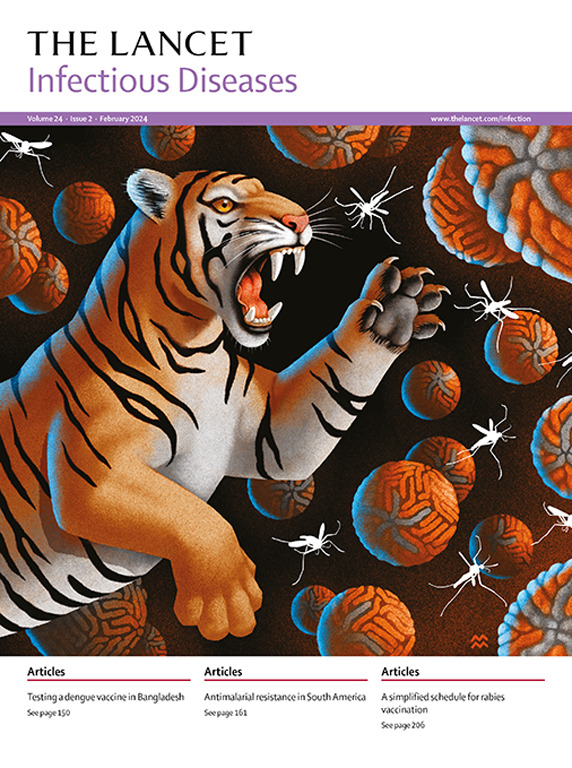14 days of high-dose versus low-dose primaquine treatment in patients with Plasmodium vivax infection in Cambodia: a randomised, single-centre, open-label efficacy study
IF 36.4
1区 医学
Q1 INFECTIOUS DISEASES
引用次数: 0
Abstract
Background
Most malaria-endemic countries, including Cambodia, use a total dose of 3·5 mg/kg of primaquine to eliminate Plasmodium vivax hypnozoites and prevent relapses. There are, however, indications that the lower dose of 3·5 mg/kg is insufficient for tropical P vivax isolates, particularly in southeast Asia, and WHO now recommends a total dose of 7·0 mg/kg in most countries. We aimed to determine the most effective regimen to eliminate P vivax hypnozoites to support elimination efforts of this malaria parasite.Methods
We conducted an open-label, randomised controlled trial in Kampong Speu province, western Cambodia. Patients infected with P vivax aged at least 15 years were offered to participate. Exclusion criteria were severe malaria or other diseases requiring treatment, low haemoglobin (<8·0 g/dL), pregnancy or breastfeeding, sensitivity to study drugs, and use of antimalarials in the preceding month. Enrolled patients were treated with an artesunate regimen of 2 mg/kg per day for 7 days. Patients with normal glucose-6-phosphate dehydrogenase (G6PD) levels were randomly assigned (2:2:1) to receive 3·5 mg/kg (low dose [0·25 mg/kg per day]), 7·0 mg/kg (high dose [0·5 mg/kg per day]), or no primaquine for 14 days. Patients with deficient G6PD levels were assigned to the no primaquine comparator arm. Patients were relocated to the study site in Aoral town where no malaria transmission occurs to ensure that they were not reinfected during their 90-day follow-up. After 90 days of relocation, G6PD-normal patients in the no primaquine arm were provided 3·5 mg/kg of primaquine for 14 days to be taken unsupervised. At day 90, relocation was terminated, and patients were followed up monthly for 3 months until day 180. The primary outcome was P vivax recurrence within 90 days of relocated follow-up, assessed in all patients who completed treatment and complied with relocation without interruption. All patients enrolled and assigned to an intervention arm were included in the safety analysis. The study is registered on ClinicalTrials.gov and recruitment is completed (NCT04706130).Findings
Between Nov 10, 2021, and Feb 10, 2024, 160 patients were enrolled and 147 were included in the primary analysis—59 were assigned to the no primaquine arm (37 assigned as G6PD deficient [median age 22 years, IQR 18–28]; 22 randomly assigned [18, 17–25]), 45 to the low-dose primaquine arm (23, 19–30), and 43 to the high-dose primaquine arm (22, 18–25). Participants were mostly male (135 [92%] of 147) and all Cambodian. 48 (81% [95% CI 69·6–89·2]) participants in the no primaquine arm had at least one P vivax recurrence within 90 days, as did 11 (24%, 14·2–38·7) in the low-dose group and two (5%, 0·8–15·5) in the high-dose group (p=0·0141 for high vs low). After imputation for missing data, low-dose primaquine remained associated with more recurrences than high-dose primaquine (hazard ratio 0·17 [95% CI 0·04–0·79], p=0·0229). Both primaquine regimens were well tolerated with no serious adverse events reported.Interpretation
Not providing primaquine to patients led to a considerable rate of P vivax recurrence. The risk of P vivax recurrence was substantially lower for 7·0 mg/kg primaquine treatment compared with 3·5 mg/kg. Tolerability and safety of both primaquine regimens in G6PD normal individuals was comparable.Funding
US National Institutes of Health (R01AI146590).柬埔寨间日疟原虫感染患者接受 14 天大剂量与小剂量伯 氨喹治疗:随机、单中心、开放标签疗效研究
本文章由计算机程序翻译,如有差异,请以英文原文为准。
求助全文
约1分钟内获得全文
求助全文
来源期刊

Lancet Infectious Diseases
医学-传染病学
CiteScore
60.90
自引率
0.70%
发文量
1064
审稿时长
6-12 weeks
期刊介绍:
The Lancet Infectious Diseases was launched in August, 2001, and is a lively monthly journal of original research, review, opinion, and news covering international issues relevant to clinical infectious diseases specialists worldwide.The infectious diseases journal aims to be a world-leading publication, featuring original research that advocates change or sheds light on clinical practices related to infectious diseases. The journal prioritizes articles with the potential to impact clinical practice or influence perspectives. Content covers a wide range of topics, including anti-infective therapy and immunization, bacterial, viral, fungal, and parasitic infections, emerging infectious diseases, HIV/AIDS, malaria, tuberculosis, mycobacterial infections, infection control, infectious diseases epidemiology, neglected tropical diseases, and travel medicine. Informative reviews on any subject linked to infectious diseases and human health are also welcomed.
 求助内容:
求助内容: 应助结果提醒方式:
应助结果提醒方式:


